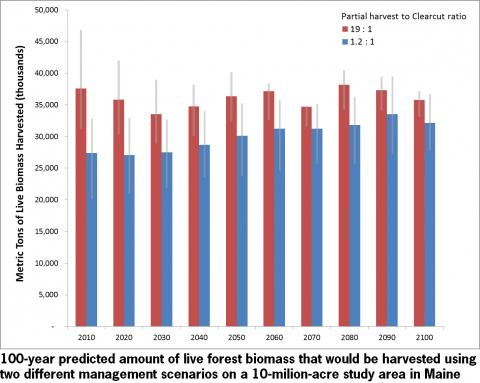Long-Term Outcomes and Tradeoffs of Forest Policy and Management Practices on the Broad-Scale Sustainability of Forest Resources: Wood Supply, Carbon, and Wildlife Habitat

Maine is a major producer of timber and wood products in the Northern Forest. Concerns over long-term sustainability of Maine’s forest resources have arisen as forest policy change, land parcelization, and ownership change have reshaped timber harvesting trends and patterns in the state and region.
NSRC researchers used the forest landscape computer model LANDIS-II (LANDscape DIsturbance and Succession) to simulate forest conditions for the next 100 years (2010-2110) across 10 million acres of commercial forestland in Maine in predominately spruce-fir forest. Researchers designed alternative scenarios of forest management to compare the current timber harvest regime, characterized by a reliance on partial harvesting, to the regime that was present prior to forest policy change in the early 1990s, which included more clearcutting but fewer total acres harvested annually.
Researchers found that current harvest rates, if maintained, will be marginally sustainable over the next 100 years, but aboveground live biomass (carbon stocks) would be greater if the relative proportion of acreage clearcut vs. partially harvested increased. Predictions also suggest that there would be more late-successional (older) forest in the future with more clearcut harvesting because fewer total acres would be harvested annually in order to achieve the same volume of timber. Wood supply, carbon stocks, and habitat availability for wildlife dependent on late-successional forest would benefit if forest management were less reliant on partial harvesting.
Download printable version (PDF)
Download full final report (PDF)
